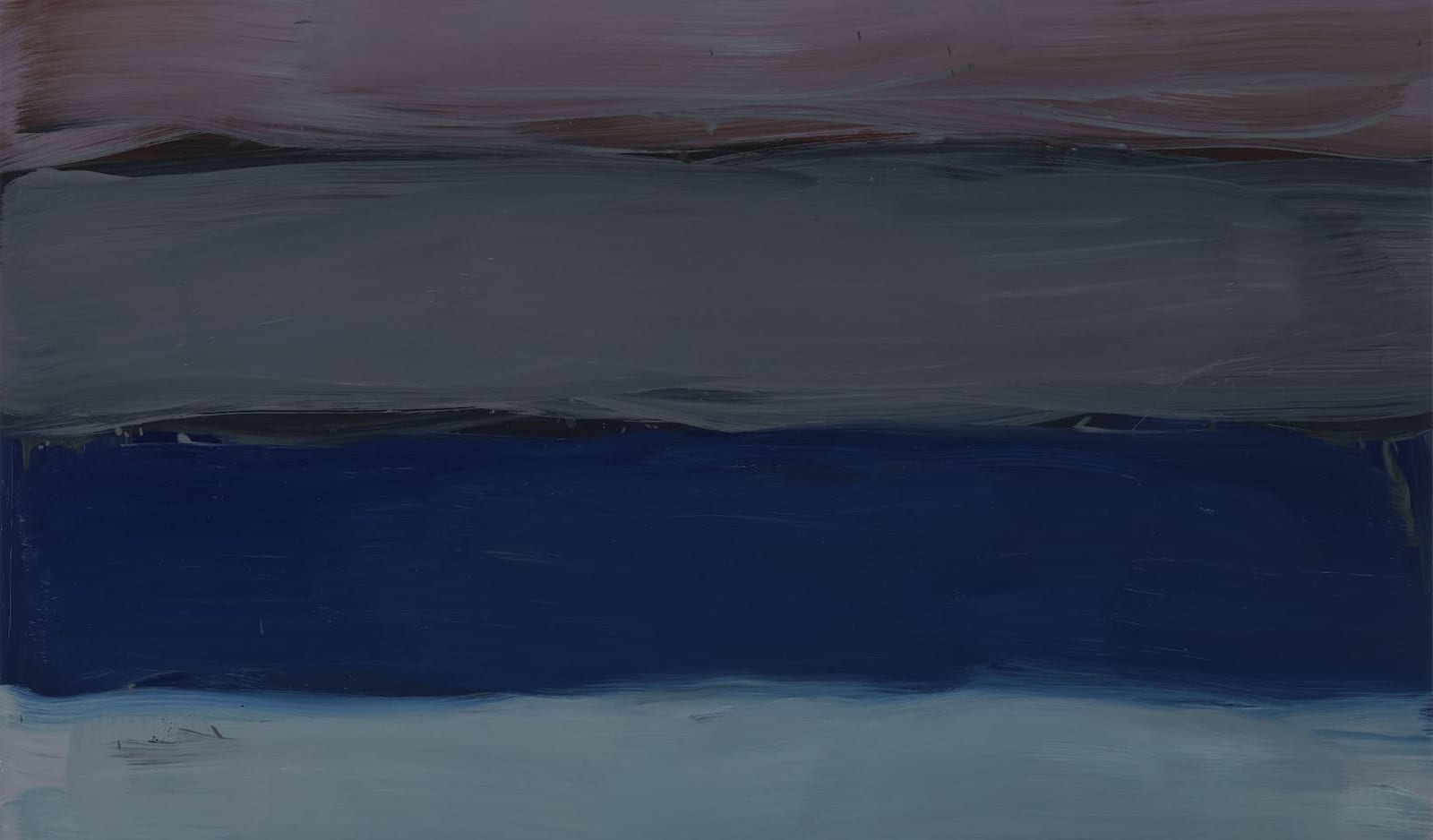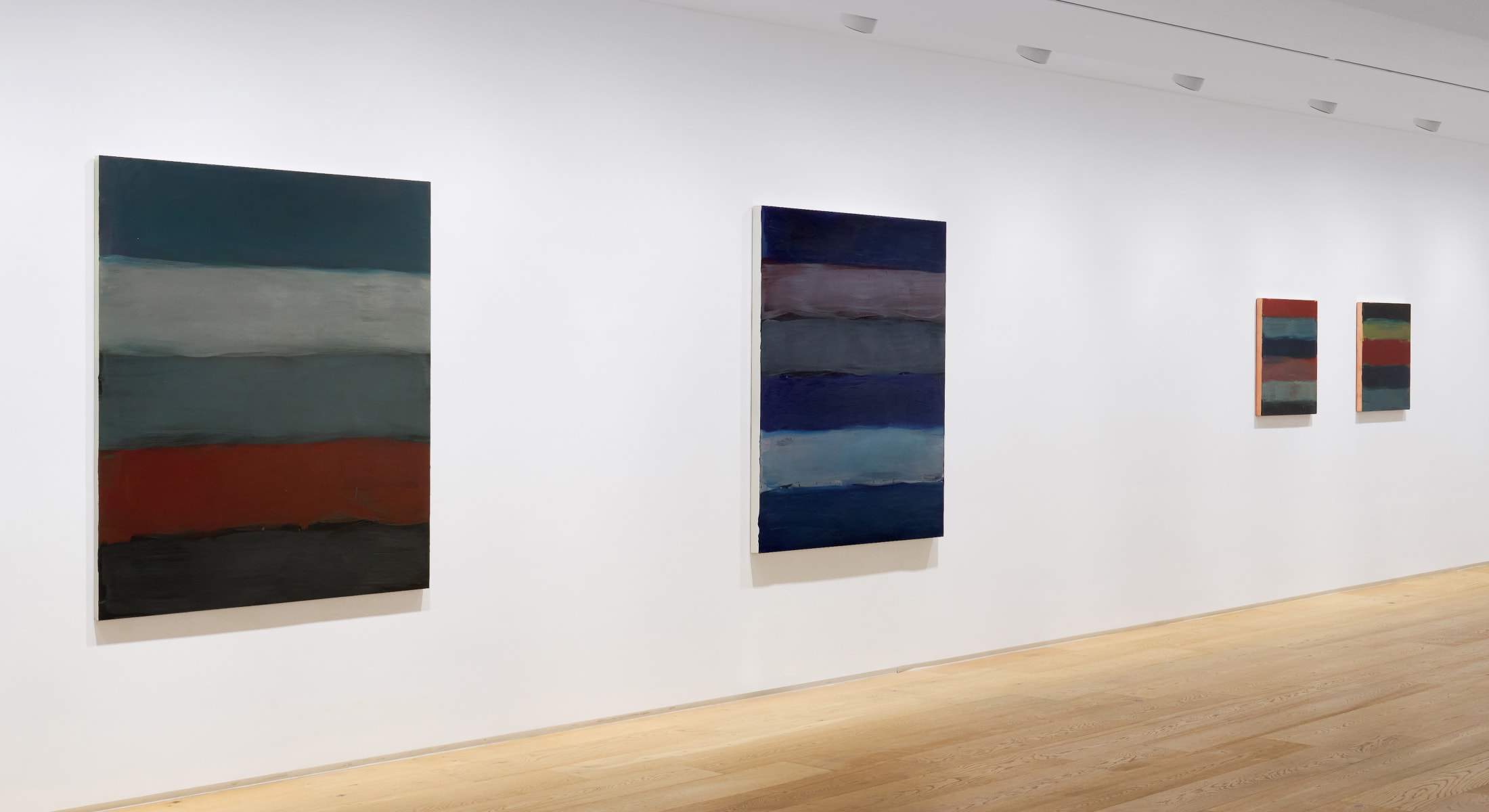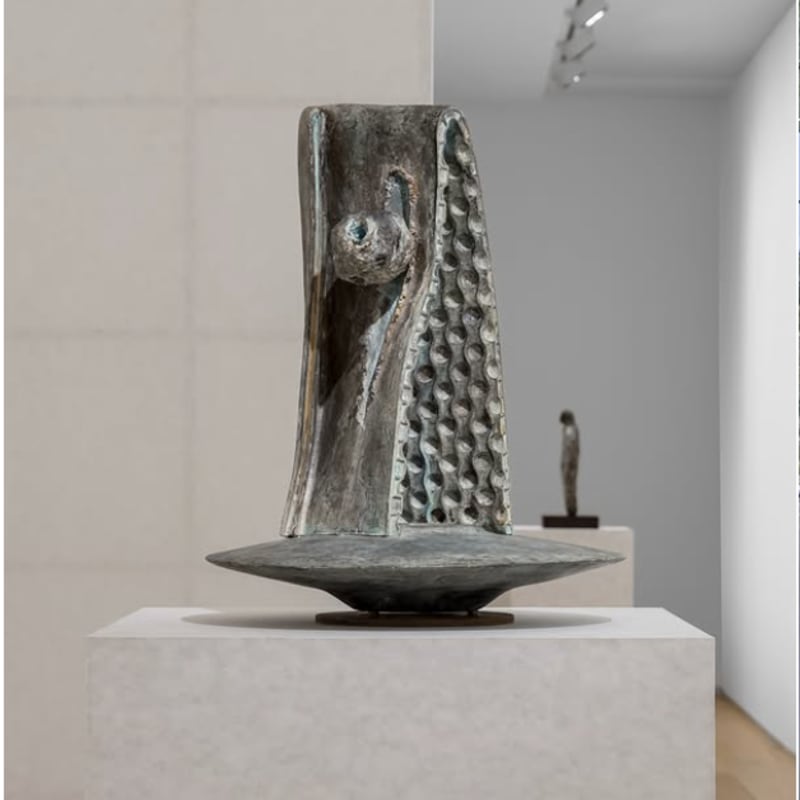
The exhibition conveys the significance of place to Scully’s ongoing formal investigation of the stripe and block motifs that structure his distinct approach to abstraction. The new paintings trace his recent return to London. The steel-grey undertone of their colour palettes evokes the brooding light of the city that surrounds his studio in Kentish Town – an area of North London referenced in the Wall of Light painting Kentish Town Blue Red (2024).
션 스컬리는 선과 블록 모티프를 주축으로 추상 탐구를 전개해 왔는데, 본 전시는 작가 작품 세계의 근간이자 그의 예술적 발전에서 중요한 위치를 차지해 온 ‘장소’의 개념에 주목한다. 철회색조의 차분한 팔레트가 눈에 띄는 신작 회화 ⟨켄티시 타운 블루 레드(Kentish Town Blue Red)⟩(2024)는 ⟨월 오브 라이트⟩ 연작에 속하는 작품으로 음울한 도시 풍경을 연상시키는데, 이는 최근 런던 켄티시 타운으로 거처를 옮긴 작가의 주변 환경을 반영한 것이다.
Kentish Town Blue Red, 2024
Oil on copper
50 x 50 cm (19.7 x 19.7 in)
Soul means your spirit... The only thing you really own is your spirit. Everything else is only rented, including your body. — Sean Scully영혼(soul)은 당신의 영성(spirit)을 뜻한다. 당신이 가진 것, 진정으로 소유한 것은 영혼뿐이다. 신체를 포함한 다른 모든 것은 빌려온 것이다. — 션 스컬리


In tandem with the influence of the urban environment, Scully cites 'the muscular light of Constable' as a key inspiration for the paintings, sharing the English landscapist’s preoccupation with capturing the specific atmospheric conditions of a particular place in a particular moment. The high contrast interplay of darkness and light characteristic of John Constable’s pastoral scenes is reimagined within his own abstract language.
스컬리는 이번 신작이 도시의 환경뿐만 아니라, 특정 장소에서 특정 순간에 포착되는 대기 를 화폭에 담고자 몰두했던 영국의 풍경화가 존 컨스터블(John Constable)이 구현하는 '정밀한 빛' 표현으로부터 지대한 영감을 받았다고 설명한다. 작가는 컨스터블의 목가적인 화면에서 이루어지는 어둠과 빛의 상호작용과 강렬한 대비 표현을 자신만의 고유한 추상 문법으로 재해석한다.
Landline Green Blue, 2024
Oil on copper
70.1 x 70.1 cm (27.6 x 27.6 in)
The Hay Wain, 1821
Oil on canvas
130.2 x 185.4 cm (51.26 x 72.99 in)

Subtly variegated blocks or stripes of blue, red, green and purple are laid down on copper, aluminium and linen. Their tonal modulations imbue the paintings with a luminosity resonant with the European landscape tradition that he draws upon, demonstrating the enduring influence of art history on his own painting practice. 'I’m really in the business of unifying these two tendencies that have been at odds in our human history for a very long time,' he has said, 'the logical and the romantic.'
구리, 알루미늄, 린넨 위에 켜켜이 쌓이는 파랑, 빨강, 초록, 보라의 선과 색채 블록은 화면 안에서 상호 작용을 이루며 은은한 광채를 품는데, 이는 유럽의 전통 풍경화뿐만 아니라 방 대한 미술사로부터 지속적으로 영향을 받아 구축된 작가의 작품 세계를 확인할 수 있는 지 점이다. 작가는 '나는 인류의 역사 속에서 오랜 시간 상충되어 온 두 가지, 즉 논리적인 것과 낭만적인 것을 통합하는 작업을 전개한다'고 말한다.
Landline Grey Blue Pink, 2024
Oil on copper
70.1 x 70.1 cm (27.6 x 27.6 in)

Making visible the processual nature of painting, Scully encapsulates the transient and ever-changing quality of natural light so that, as art critic Hans-Joachim Müller describes, each painting 'has its own climate, its own emotional profile.' While Wall London Green (2024) lays down sunshine yellow next to spring green and rose pink to evoke the warm light of a summer’s day, the peaches and oranges that simmer between the blocks of Kentish Town Blue Red evoke the burnt out colours of sunset.
스컬리는 회화의 본질과 과정을 가시화함으로써 끊임없이 변화하는 찰나적인 빛의 특성을 포착하는데, 이에 대해 독일 미술 평론가 한스-요아힘 뮐러(Hans-Joachim Müller)는 '그 의 그림은 각각고유한 대기와 감정적 형세를 지니고 있다고 설명한다. 황록색과 장밋빛 분 홍 색조 옆으로 마치 노란 햇살이 내리듯 구성된 ⟨월 런던 그린(Wall London Green)⟩(2024)이 마치 여름날의 따뜻한 빛을 연상시킨다면, ⟨켄티시 타운 블루 레드⟩(2024)는 청 색과 붉은 빛의 색조 블록 사이로 복숭아와 오렌지 빛깔이 뭉근하게 피어오르며 마치 그을 린 석양을 떠올리게 한다.
Wall London Green, 2024
Oil on linen
172.7 x 157.5 cm (68 x 62 in)

The new Landline works find revitalised inspiration in musical serialism – a method of composition that repeats musical elements with variations achieved through tone, dynamics and timbre. Translating the method into painterly abstraction, the Landline works repeat the motif of the horizon line five or six times, finding their variations through tonal modulations of colour and the gestural range of the artist’s brushstrokes.
본 전시에서 선보이는 신작 회화 연작 ⟨랜드라인⟩은 작곡 기법인 음렬주의로부터 영감을 받아 출발되었다. 작가는 음, 음색, 리듬과 같은 음악적 요소들을 나열하고 반복함으로써 곡을 구성하는 기법을 자신만의 추상 언어로 치환한다. 작가는 수평의 선을 5-6회 반복적으로 그려냄으로써 붓놀림의 반경을 확장하고, 이 과정에서 색은 저마다의 변용과 변주를 거치며 자리하게 된다.
Landline Drifting, 2024
Oil on aluminium
152.4 x 134.6 cm (60 x 53 in)

While formally evocative of the colour field paintings of Mark Rothko, Scully asserts a fundamental distinction between the invocation of the sublime pursued by the American Abstract Expressionists and his own practice, which addresses contemporary existential relationships with the environment through an invocation of land through horizontal lines.
수평선을 활용한다는 점에서 일견 마크 로스코(Mark Rothko)의 색면 회화와 교차하는 듯 보일 수 있으나, 스컬리가 나아가고자 하는 방향은 결이 다르다. 미국 추상표현주의자들이 일종의 숭고미를 추구했다면, 작가는 수평선으로 대지를 환기하며 우리를 둘러싼 환경과의 현대적 실존 관계를 다루고자 한다.
Wall Landline Uranus, 2022
Oil on aluminium
215.9 x 190.5 cm (85 x 75 in)

Together, the works on view encompass the artist’s evocative expression of light through his attuned sensitivity to colour. Shaped by his deeply felt relationship to place, they represent the close entwinement of personal experience and formal investigation that continues to underpin his artmaking practice. 'Your sense of colour is like your singing voice, he says, it comes out of your spirit.'
본 전시를 통해 스컬리의 섬세한 색채 사용과 고유한 빛의 표현을 조명하고자 한다. 작가는 자신이 몸담은 혹은 영감을 얻은 장소와 깊은 관계를 형성하고 그를 작품에 적극 반영시키 는데, 이렇듯 개인적인 경험과 작가적 탐구를 결합하는 방식으로 작업하는 그는 '색에 대한 감각은 노래하는 목소리와도 같다. 그것은 당신의 영혼에서 나온다'고 이야기한다.
Landline Grey, 2024
Oil on aluminium
152.4 x 139.7 cm (60 x 55 in)

Oil on aluminium
216 x 191 cm (85.04 x 75.2 in)
By abstracting our relationship with nature we’ve made it more remote. So, what I’ve done with these paintings is move it more towards nature without giving up abstraction. — Sean Scully우리는 자연과의 관계를 추상화함으로 써 자연과 더욱 멀어졌다. 나는 이 작품들을 통해 추상을 놓지 않음과 동시 에 자연에 한 발짝 다가가고자 했다. — 션 스컬리





















































































































































































